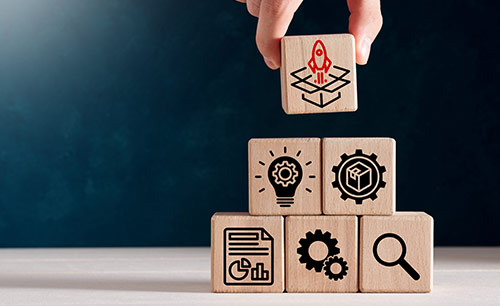
Innovation and Product Development
Definition of product development
Product development is a complex process that begins with an analysis of future trends and current customer needs, continues with the generation and development of technological ideas, and ends with the product market launch. If the product development process is characterized by a high degree of novelty, it is referred to as innovation.
Phases within product development
The central objective of product development is to maintain and expand a company's long-term competitiveness through innovative products and features. After this, further tasks arise that can be assigned to different phases.

The phases build on each other but should not be interpreted as static and linear. For example, new findings or changing market conditions may require going a phase back and going through it again.
Phase 1: Customer and trend analysis
As a basis, current customer requirements and/or complaints are first surveyed and analyzed, e.g., through customer surveys. Additionally, future trends are evaluated, and conclusions are drawn for future product developments. Included in considerations are the current and future market conditions.
Phase 2: Idea generation and evaluation
In the second step, ideas are generated and evaluated with the help of brainstorming, creative workshops, or innovation software. The evaluation of new product ideas usually takes place in various stages. It starts with more general evaluation criteria (such as the degree of novelty or general potential of the idea), followed by a more detailed evaluation (such as cost-benefit ratio or feasibility).
Also, perspectives are considered when evaluating ideas, as stakeholders may have different product expectations. For example, customers tend to focus more on the benefits and ease of use, while internal stakeholders tend to pay more attention to the cost structure or production scalability.
Phase 3: Concept development
To develop a concept, the best ideas are expanded to include more in-depth questions. The questions include the design of the implementation, including technological aspects and, if necessary, patent application.
Phase 4: Implementation
A roadmap can be defined for implementation, for example, which contains milestones up to the market launch. Depending on the complexity of the product development (e.g. the involvement of suppliers), project plans are drawn up or agile project management methods are used. A prototype of the innovation is often developed first.
Phase 5: Market launch
In preparation for the market launch, the product or prototype can be tested for acceptance in a market, for example. In this way, the risk can be limited and any errors in product development can be uncovered. The findings from the test phase are then used to adapt the product concept or the previously defined roadmap. Once all the results have been considered, the product can then be launched on the market.
Responsibilities within product development
Depending on the company’s organizational structure, the product development department may be responsible for the entire process or only for individual steps. For example, the analysis of customer needs and future trends can be carried out by marketing or the market launch by sales.
If the resources are not available internally, it is also increasingly common for external market research companies to be commissioned to support the product development process at the beginning - by analyzing customer needs and future trends and analyzing and evaluating ideas or concepts.
Source: innolytics.de
Further information
If you would like to learn more about how your company can benefit from market research within product development, please contact us. We will be happy to discuss options and research designs that will optimally support your company during the product development process.
Text written by Alica Gratza